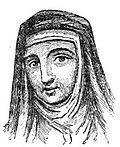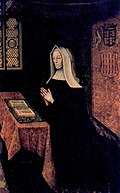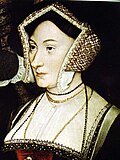List of 999 women of the Heritage Floor / Christine de Pizan
This list describes the place setting for Christine de Pizan on the table of Judy Chicago's art installation The Dinner Party . It is part of the list of 999 women on the Heritage Floor who are assigned to the respective place settings on the table. The names of the 999 women are on the tiles of the Heritage Floor, which is arranged below the table and belongs to the art installation.
description
The installation consists of a three-sided table, each with 13 historical or mythological personalities, thus a total of 39 people, from prehistory to the women's rights movement . These people were assigned a place setting at the table, consisting of an individually designed table runner, an individually designed plate, a goblet, knife, fork, spoon and serviette. The first page of the table is devoted to prehistory up to the Roman Empire , the second to Christianization up to the Reformation and the third from the American Revolution to the women's movement. Each place setting on the table is assigned additional personalities who have received an entry on the tiles of the Heritage Floor, which occupies the space under the table and the center of the space between the sides of the table. This list includes the personalities assigned to Christine de Pizan's place setting. Your seat is on the second side of the table.
Hints
In addition to the names as they are used in German transcription or in scientific usage, the list shows the spelling chosen by Judy Chicago on the tiles.
The information on women who do not yet have an article in the German-language Wikipedia is referenced by the individual references listed under comments . If individual information in the table is not referenced via the main article, additional individual references are given at the relevant point. If there are any discrepancies between the information provided in Wikipedia articles and the descriptions of the work of art on the Brooklyn Museum website , this will also be indicated under Comments.
Place setting for Christine de Pizan
Christine de Pizan was born in Venice in 1364. Her father was the astrologer and doctor Tommaso da Pizzano. Pizzano was appointed to the court of Charles V as an astrologer and personal physician and so Christine de Pizan came to Paris at the age of four. Her father gave her lessons in Latin , geometry and arithmetic , Pizan himself read extensively older and contemporary, theological and profane literature in French and Latin. She was married at the age of fifteen to the royal secretary Étienne du Castel, with whom she had three children. He died of an epidemic in 1390; her father had died three years earlier and Christine de Pizan had to fight for her inheritance and the family's financial security. In addition to her children, she looked after her mother and two teenage brothers. Under these circumstances and with no fortune she could not hope to remarry. She beganto write ballads , lais and rondeaus . For her children she wrote the educational book Book of Wisdom , which shededicatedto Philip the Bold for the usual fee. Other wealthy patrons became aware of her and she dedicated further works to the French Queen Isabeau de Bavière and the dukes Johann von Berry , Ludwig von Orléans and Johann Ohnefurcht von Burgund , the successor of Philip the Bold.
Her work as a poet was initially devoted to love, in which she also lamented the loss of her husband. Later she wrote doctrinal philosophical works in verse and prose . In politically motivated works she responded to the civil war of the Armagnacs and Bourguignons in France, in which England was repeatedly drawn into the disputes. In 1399 she criticized the misogyny of the men in her social circle. From today's perspective , she completed her most interesting work Le Livre de la Cité des Dames in 1405. In this early work, which was about equality between men and women, which from today's perspective is one of the first feminist works in Europe and which triggered the Querelle des Femmes , she uses the example of significant women from biblical and profane history the misunderstood abilities of women and develops the image of a utopian society in which women are granted equal rights.
Her last work, a praise, the Dictié en l'honneur de la Pucelle , Jeanne d'Arc , the "Maid of Orléans", was published in 1430 in Poissy , where Christine de Pizan has been with her daughter Marie in the convent of the Dominican Sisters of Saint-Louis de Poissy lived. Thereafter nothing is known about them. Presumably she died in Poissy soon after 1430.
Lively red and green tones dominate the table setting for Christine de Pizan. Your plate is designed with an abstract swirling butterfly shape. For Chicago, this form is intended to represent a gesture of defense, symbolizing efforts to protect women. The table runner is kept in the same color tones that lick the middle of the runner like serrated tongues of flame. The wave-shaped, colorful pattern is characteristic of the Bargello needle point , which is also known as "flame stitch" or "Florentine stitch". The initial letter "C" on the front of the table runner shows the scene in which Pizan presents her work to the Queen of France Isabeau de Bavière.
| Surname | Spelling on the tile | Date of birth | cultural spatial assignment | Remarks | image |
|---|---|---|---|---|---|
| Agnes Randolph | Agnes of Dunbar | around 1312 | Scotland | Known as Black Agnes , she defended the family castle, Dunbar Castle , while her husband, Patrick V, Earl of March , was at war. |

|
| Aliénor de Poitiers | Aliénor de Poitiers | 15th century | Kingdom of France | Author of Les honneurs de la cour , a book on court ritual and etiquette for all social classes. She has been described as the 15th century Emily Post . | |
| Anastasia | Anastasia | before 1400 | Kingdom of France | Anastasia has been named by the philosopher and poet Christine de Pizan as one of the most talented manuscript illuminators of her generation. She worked in Paris at the beginning of the 15th century. | |
| Angela Merici | Angela Merici | 1474 | Duchy of Milan | Founder of the Compagnia di Sant'Orsola , from which the religious order of the Ursulines developed. |

|
| Beatrice Galindo | Beatrice Galindo | 15th century | Kingdom of Castile | Writer, humanist and teacher to Queen Isabella I of Castile and her children. |

|
| Burgot Le Noir | Burgot | 14th century | Kingdom of France | Illuminator , daughter and student of Jean Le Noir , from whom she learned book illumination. | |
| Clara Hätzlerin | Clara Hatzerlin | 1430 | Holy Roman Empire , Augsburg | 15th century wage clerk . She is the only documented woman who made handwritten copies of German codes against payment . | |
| Cobhlaith Mór Ní Conchobhair | Cobhlair Mor | 14th century | Ireland | Wealthy Irish woman and guardian of Gaelic customs at a time when Edward III. were undermined by England. | |
| Francisca de Lebrija | Francisca de Lebrija | 16th century | Kingdom of Castile | Lecturer at the University of Alcalá de Henares in Spain. | |
| Ingrid Persdotter | Ingrida | 14th century | Sweden | St. Birgitta Monastery in Vadstena . She is famous for writing passionate love letters to a knight named Axel Nilsson in 1498. | |
| Isotta Nogarola | Isotta Nogarola | 1418 | Republic of Venice | Humanist and author . |

|
| Jane Anger | Jane Anger | 16th century | England | Author and the first woman to publish a full defense of her gender in English. The title of Her Defense, Jane Anger Her Protection For Women , was published in 1589. | |
| Juliana Berners | Juliana Bernes | around 1400 | England | Writer and Prioress of Sopwell Monastery near St Albans . |

|
| Maddalena Buonsignori | Maddalena Buonsignori | 14th century | University of Bologna | Law professor at the University of Bologna . | |
| Marfa Boretskaya | Martha Baretskaya | 15th century | Novgorod | Allegedly led the struggle for Novgorod against the Grand Duchy of Moscow and the annexation of the city by Ivan III. of Russia 1478. |

|
| Margaret Beaufort | Margaret Beaufort | 1443 | England | Renaissance princess , mother of Henry VII. Of England , founder of the St. John's College of the University of Cambridge . |

|
| Margaret O'Carroll / Mairgréag Ní Chearbhaill / Failge | Margaret O'Connor | 15th century | Ireland | Noblewoman who was known for her piety and hospitality. | |
| Margaret Paston | Margaret Paston | 14th century | England | Wrote some of the Paston Letters , a collection of correspondence between members of the Paston family of Norfolk and others who were in touch with them in England from 1422 to 1509. The collection also contains state gazettes and other important documents. | |
| Margaret Roper | Margaret Roper | 1505 | England | Translator and author, eldest daughter of Sir Thomas More . |

|
| Margareta Karthäuserin | Margareta Karthauserin | 15th century | Holy Roman Empire , Katharinenkloster Nuremberg | Nun in the Dominican monastery of St. Katharina in Nuremberg and a highly skilled typist. | |
| Margery Kempe | Margery Kempe | 1373 | England | Mystic and visionary, known for her Middle English script The Book of Margery Kempe . | |
| Modesta Pozzo | Modesta Pozzo | 1555 | Republic of Venice | Venetian writer , author of the “ proto-feminist polemic ” The Merit of Women . |

|
| Rose de Burford | Rose de Burford | 13th century | England | Businesswoman and businesswoman in the City of London. | |
| Teresa de Cartagena | Teresa de Cartagena | around 1425 | Kingdom of Castile | A nun who wrote the Admiraçión operum Dey ( Miracles in the Works of God ), considered to be the first feminist scripture written by a Spanish woman. |

|
- Individual evidence
- ↑ Brooklyn Museum: Christine de Pisan. In: brooklynmuseum.org. Retrieved October 25, 2019 .
- ^ Brooklyn Museum: Aliénor de Poitiers. In: brooklynmuseum.org. Retrieved September 22, 2019 .
- ^ Brooklyn Museum: Anastasia (Christine de Pisan group). In: brooklynmuseum.org. Retrieved September 22, 2019 .
- ^ Brooklyn Museum: Beatrix Galindo. In: brooklynmuseum.org. Retrieved October 25, 2019 .
- ↑ Brooklyn Museum: Bourgot. In: brooklynmuseum.org. Retrieved October 25, 2019 .
- ↑ Brooklyn Museum: Cobhlair Mor. In: brooklynmuseum.org. Retrieved October 25, 2019 .
- ↑ Brooklyn Museum: Francisca de Lebrija. In: brooklynmuseum.org. Retrieved October 25, 2019 .
- ↑ Brooklyn Museum: Ingrida. In: brooklynmuseum.org. Retrieved October 25, 2019 .
- ↑ Brooklyn Museum: Jane Anger. In: brooklynmuseum.org. Retrieved October 25, 2019 .
- ^ Brooklyn Museum: Maddalena Buonsignori. In: brooklynmuseum.org. Retrieved October 25, 2019 .
- ↑ Brooklyn Museum: Martha Baretskaya. In: brooklynmuseum.org. Retrieved October 25, 2019 .
- ^ Brooklyn Museum: Margaret O'Connor. In: brooklynmuseum.org. Retrieved October 25, 2019 .
- ^ Brooklyn Museum: Margaret Paston. In: brooklynmuseum.org. Retrieved October 25, 2019 .
- ↑ Brooklyn Museum: Rose de Burford. In: brooklynmuseum.org. Retrieved October 25, 2019 .
- ↑ Brooklyn Museum: Teresa de Cartagena. In: brooklynmuseum.org. Retrieved October 25, 2019 .
Web links
- Brooklyn Museum, Christine de Pizan
- The Dinner Party on the website of Through the Flower , Judy Chicago's non-profit organization
